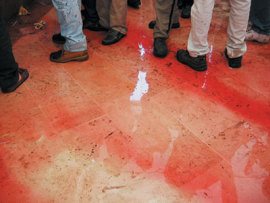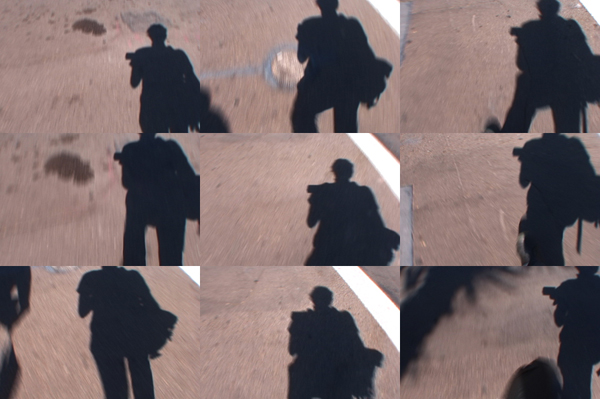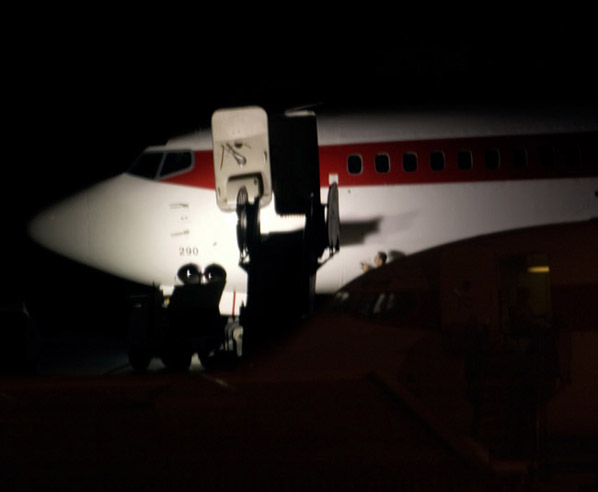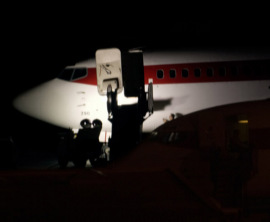
Interventions
Intervention/Insertion - Rula Halawani: Intimacy
I would like to insert into the conversation on behalf of Rula Halawani a series of images from a work titled "Intimacy." Additional images can be found here, and description of the work are below.
> Caleb
These series of photographs were taken at the Qalandia checkpoint. This body of work examines and captures the experience of the checkpoint which has become a hallmark of the current Israeli occupation. There are very few faces among the collection of images; rather we are invited to view a multitude of close-ups of encounters between soldiers and Palestinians wanting to cross the border.
One of the distinctive characteristics of the Israeli occupation is its highly personalized quality and the particular way in which it invades and penetrates the private space of individuals. At 'the checkpoint' there are no privileges, everyone waits in line, and is reduced to an ID number, and everyone is searched and questioned. It is these qualities and aspects that are conveyed in my photographs, in particular the repetitive inspections of papers and personal belongings. However, what is intriguing about the photographs is how they document the subtleties of the encounters between two anonymous parties. In the images we see different gestures of waiting and the postures of human bodies placed in an unequal power relationship. Via the close-ups, we get a sense of people's different moods - tiredness, anxiety - and the nuances of the way each person responds to questioning at the checkpoint.
Shown through fragments, this series of photographs carries a multitude of narratives on the experiences of Palestinians at Qalandia. In a sense, when looking at the images, you can hear the echo of people's voices as you imagine the all too familiar dialogues that take place. I accentuate the issues of repetition and the differences between each separate encounter by the recurrence in this series of the large slab of worn stone that marks the site of exchange. In many of my photographs, it is given particular prominence and takes on a symbolic quality marking nearness and distance at the same time, it becomes the one fixed element or prop in this absurd theatre. Imposed on the landscape, it marks the place where the ritual of authority is performed and the place of contact with the other.
The particular angle I used in my photographs shows the experience and phenomena of the checkpoint in all its mundane and chilling detail and documents how power in the modern days is exercised and inscribed on individuals.
> Rula Halawani
Jalal Toufic: 'Âshûrâ'; or, Torturous Memory as a Condition of Possibility of an Unconditional Promise
To download as PDF click here

Can one still give and maintain millenarian promises in the twenty first century? But first, a more basic question: can one still promise at all?
Al-Husayn, the grandson of the prophet Muhammad and the son of the first Shi‘ite imâm, ‘Alî b. Abî Tâlib, was slaughtered alongside many members of his family in the desert in 680. This memory is torture to me.
| “I am not allowed to weep, because I’ll become blind were I to do so,” says old Victoria Rizqallah at the end of my video ‘Âshûrâ’: This Blood Spilled in My Veins, 2002. But wouldn’t losing the ability to weep be even more detrimental and sadder than going blind? I would prefer to (be able to) weep even were I to go blind as a result of that—to weep over going blind? Isn’t that better than becoming inhuman? “For others too can see, or sleep, / But only human eyes can weep” (Andrew Marvell, “Eyes and Tears”). |  |
read more
Caleb Waldorf: Ecologies of Suspicion

Scenario
You are on vacation. As any good tourist you have your camcorder and are filming everything in sight.
-cut-
You dump your video to your computer after arriving to your hotel. While watching the footage you notice that you accidentally left the camera running. It captured your shadow traversing the sidewalk and intersection as you crossed the street. You laugh at yourself, close your computer for the night to get ready for the long plane ride home tomorrow.
-cut-
At the airport you check your bags and prepare to go through inspection. You've worn slip-ons. Keys and change are stashed in your bag. You’ve already pulled your laptop out, and are ready to pass quickly through security. As you meet the first in a series of security guards your ID and boarding pass is held upright and ready. You smile innocently, if not somewhat guiltily waiting to be passed to the next step. The security guard tells you to go stand to the side and wait. Your boarding pass has been marked and you must go through further inspection. You are taken to a small cubicle and asked a series of questions. You explain that there must be some mistake, you were just on vacation and returning home. The officer ignores your claim and decides that he needs to look through your bag and your computer. He boots up your computer, and notices a movie file on your desktop titled "site-seeing.mov." He opens the file and begins to watch. read more
Trevor Paglen: Limit Telphotography

I'm Trevor Paglen, and I've been asked to provide some of the visual interventions this week. Here's a brief introduction to my work:
For the last 5 years or so, I've been interested in the space of military secrecy from a number of angles (visual, juridical, material, etc...). I'm currently finishing up a PhD in the Department of Geography at UC Berkeley about all of this. I also recently published a book (with co-author AC Thompson) about the 'extraordinary rendition' program and the CIA's network of 'black sites' around the world. I try to combine art, scholarship, and research in a fluid, seamless, way.
One of the sub-projects within this body of work is a series I've been called "Limit Telephotography" - it's a series of photographs I've been taking of "black" or unacknowledged military bases, most of which are in the southwestern United States.
I've also had the opportunity to photograph some of these CIA 'black sites' while running around the world researching the "Torture Taxi" book, but those images will become public at a show in New York opening on November 16th. read more


